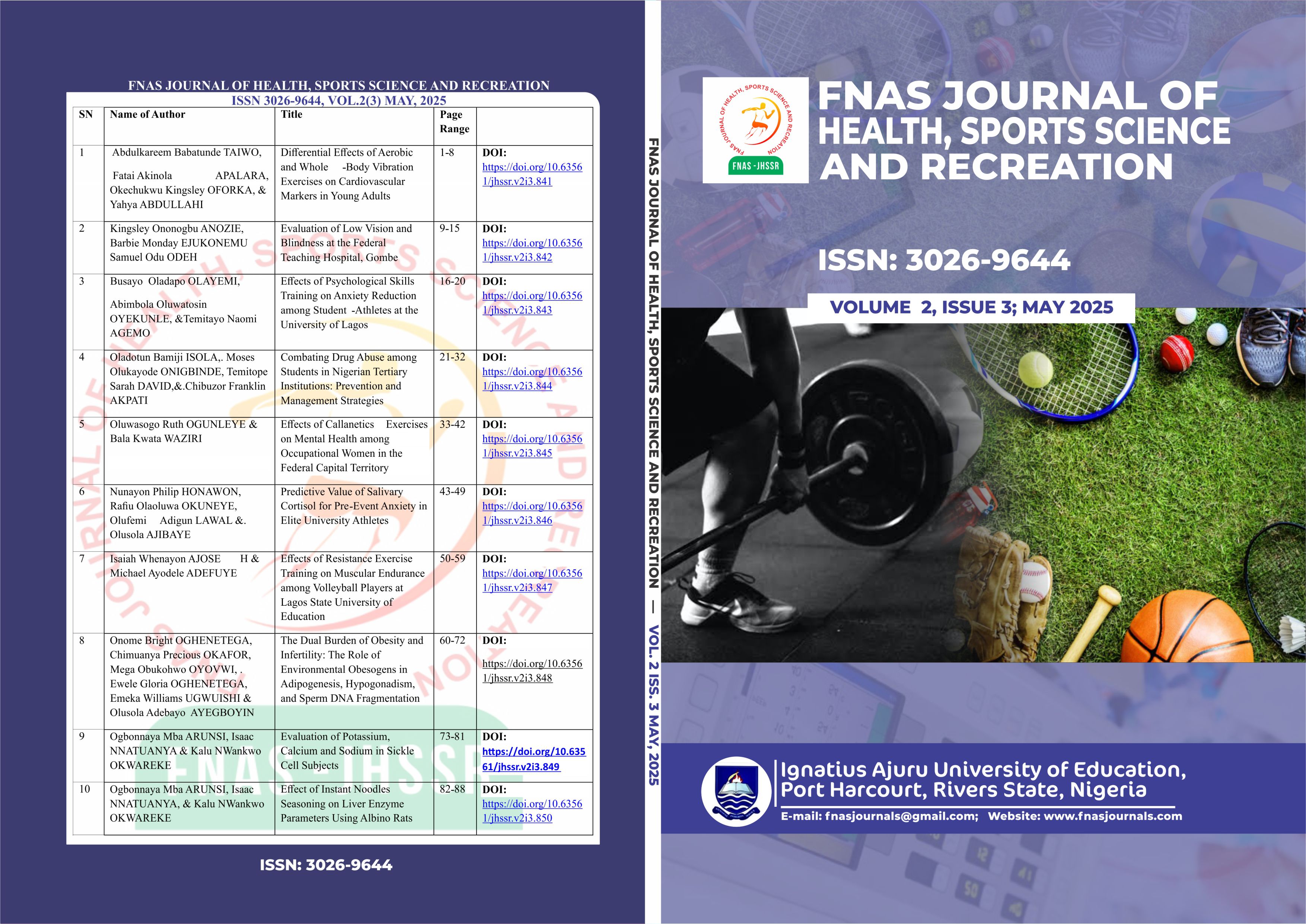Differential Effects of Aerobic and Whole-Body Vibration Exercises on Cardiovascular Markers in Young Adults
DOI:
https://doi.org/10.63561/jhssr.v2i3.841Keywords:
Aerobic Exercise, Whole-Body Vibration Exercise, Heart Rate Variability, Cardiovascular Variables, Blood PressureAbstract
Cardiovascular diseases remain a global health challenge, with physical inactivity being a key contributing factor. This study investigated the acute effects of two exercise modalities, traditional aerobic exercise and whole-body vibration (WBV) exercise, on cardiovascular variables in young adults. The study adopted a randomised controlled trial with 20 apparently healthy participants who were assigned to either an aerobic exercise group, which performed a 30-minute session on a bicycle ergometer, or a WBV group, which engaged in a 30-minute session on a horizontal vibrating platform with dynamic and static exercises. Pretest and posttest measurements were taken for systolic blood pressure (SBP), diastolic blood pressure (DBP), heart rate (HR), and heart rate variability (HRV). Aerobic exercise increased SBP from 112.3 ± 9.4 to 132.4 ± 11.2 mmHg (Δ 20.1 ± 14.6 mmHg, p = 0.013), while DBP rose from 71.8 ± 7.2 to 79.5 ± 8.1 mmHg (Δ 7.7 ± 5.3 mmHg, p = 0.027). Both changes are within the safe, expected acute response (< 30 mmHg for SBP and < 10 mmHg for DBP) for healthy young adults. In the WBV group, systolic blood pressure changed by −1.43 ± 7.18 mmHg (p = 0.470) and diastolic blood pressure by −0.93 ± 8.94 mmHg (p = 0.704), indicating negligible acute effects on blood pressure. In contrast, heart rate increased by 8.60 ± 1.81 bpm (p = 0.011), and heart rate variability rose by 5.69 ± 0.91 ms (p = 0.035). Both the heart rate and HRV changes fall within the safe, expected acute response range for healthy young adults (< 10 bpm for HR and < 10 ms for HRV). Between-group analyses revealed statistically significant differences in heart rate and heart rate variability responses, suggesting that aerobic exercise has more pronounced acute cardiovascular effects compared to WBV exercise. These findings support the incorporation of aerobic exercise into routine physical activity programs for more effective cardiovascular modulation while suggesting that WBV exercise may serve as a complementary modality with minimal cardiovascular strain.
References
Adebayo, T., Ibrahim, Y., & Sulaimon, R. (2022). Effects of whole-body vibration and aerobic exercise on blood pressure: A comparative analysis. Journal of Cardiovascular Exercise, 12(3), 45-52.
Adebayo, T., Ibrahim, Y., & Sulaimon, R. (2022). Effects of whole-body vibration and aerobic exercise on blood pressure: A comparative analysis. Journal of Cardiovascular Exercise, 12(3), 45-52.
Akinola, A., Ige, K., & Adewunmi, O. (2020). The effect of aerobic exercise intensity on diastolic blood pressure in young adults: A controlled trial. Exercise Science Review, 8(2), 123-130.
Ekechukwu, A. U. (2021). A comparison of the impact of aerobic and vibration exercises on cardiovascular markers in hypertensive adults. Journal of Hypertensive Research, 22(1), 59-70.
Esan, J.A & Nweke E.O., (2022). Effects Of Aerobic Dance on Cardiovascular Variables of Junior Secondary School Students. Journal of Human Kinetics and Health Education Pedagogy 4(1).
Ibrahim, A. O., & Adebayo, T. (2021). Aerobic vs. whole-body vibration exercises: Effects on diastolic blood pressure in young adults. Nigerian Journal of Physiotherapy, 18(3), 87-95.
Lau, W.Y., Yip, S.P., & Pang, M.Y. (2012). Whole-body vibration has minimal impact on the neuromuscular function of healthy older adults. Clinical Interventions in Aging, 7, 273-278.
Liao, L.R., Ng, G.Y., & Jones, A.Y. (2015). Whole-body vibration: a review of its current state as a potent exercise intervention. Clinical Rehabilitation, 29(11), 1103-1119.
Nyberg, M., Jensen, L.G., & Bangsbo, J. (2012). Role of cytokines in vasodilation during exercise. Cardiovascular Research, 96(3), 452-459.
Odeyemi, B., Aderemi, F., & Adeoye, O. (2022). The effect of different exercise modalities on diastolic blood pressure in adults: Aerobic versus whole-body vibration exercises. Nigerian Journal of Sports and Exercise Physiology, 14(2), 89-95.
Ogunjimi, A., Olusola, A., & Bello, A. (2019). The role of whole-body vibration training in prehypertension management: A randomised controlled trial. Journal of Sports Medicine, 11(2), 201-209.
Ogunleye, B.O & Ojo O.R (2019). Impact of physical fitness activities on students’ Basic Science achievement in selected Nigerian secondary schools. Technical University of Varna Annual Journal. 3(2): 12-31 DOI: https://doi.org/10.29114/ajtuv.vol3.iss2.145
Ojo, A., Adesina, R., & Adewale, Y. (2019). Acute effects of aerobic exercise on blood pressure in young adults. International Journal of Exercise Science, 12(4), 234-241.
Okeneye, R.O. (2013). Human Body, Human Wellness: The Perpetual Antidotes. Lagos State University 50th Inaugural Lecture.
Olamide, O., Adebayo, O., Emmanuel, A., Eyitayo, L., Beatrice, O., & Tomisin, M. (2023). Prevalence and Risk Factors of Cardiovascular Diseases among the Nigerian Population: A New Trend among Adolescents and Youths. IntechOpen. doi: 10.5772/intechopen.. 108180 DOI: https://doi.org/10.5772/intechopen.108180
Pang, M.Y., Lau, R.W., & Yip, S.P. (2013). The effects of whole-body vibration therapy on bone turnover, muscle strength, motor function, and spasticity in chronic stroke: a randomised controlled trial. European Journal of Physical and Rehabilitation Medicine, 49(4), 439-450
Taiwo, A.B, Apalara, F.A, & Okuneye, R.O. (2022). Effect of Aerobic Exercise on Selected Cardiometabolic Risk Factors of Prehypertensive Adolescents in Lagos State. Journal of Nigeria Association of Physical, Health Education, Recreation, Sports and Dance (JONAPHER-SD) 2(1)
Taiwo, A.B. (2022). Exercise Behaviour of Female Religious Conservatives in Ojo Local Government, Lagos, Nigeria. International Journal of Christianity and Sports 1 (1)
Taiwo, A.B, Apalara, F.A., & Williams, J.O. (2023). Effect of Whole-Body Vibration Exercise on Selected Health-Related Physical Fitness Components of Young Adults. Journal of Human Kinetics and Sports Science (JOHKASS) 7(1), 123-136
World Health Organisation (2018). Cardiovascular diseases. Retrieved from https://www.who.int/news-room/fact sheets/detail/cardiovascular-diseases-(cvds)


